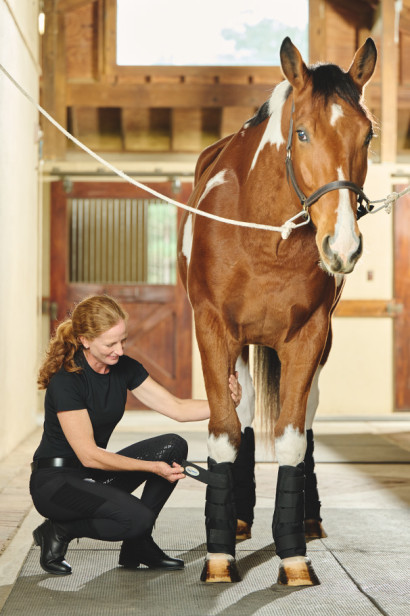Why Equine Therapy is Coming To Be a Preferred Choice for Emotional Wellness
Why Equine Therapy is Coming To Be a Preferred Choice for Emotional Wellness
Blog Article
How Laser Therapy in Equine Treatment Is Transforming Veterinary Treatment for Equines
Laser treatment has emerged as a transformative strategy in equine veterinary care, giving a non-invasive service that accelerates recovery and boosts total health. Leveraging precise light wavelengths, this innovative therapy stimulates cellular regeneration, lowers swelling, and mitigates discomfort. Its effectiveness expands from musculoskeletal injuries to chronic ailments like osteoarthritis, substantially enhancing mobility and life quality for horses. The mobility and convenience of laser therapy devices additionally underscore their growing necessity among vets. As we explore the detailed mechanics and real-world successes, the extensive influence on equine clinical methods comes to be significantly obvious.
Comprehending Laser Treatment

The modern technology behind laser therapy is based in the principle of photochemistry, where photons are soaked up by chromophores within cells, leading to boosted ATP manufacturing and inflection of responsive oxygen species (Equine Therapy). This, in turn, promotes mobile proliferation, decreases inflammation, and accelerates healing. Vet professionals utilize different sorts of lasers, including low-level lasers (LLLT) and high-power Class IV lasers, depending upon the particular restorative purposes and the nature of the equine condition being treated
Different laser wavelengths and power settings are thoroughly selected to target numerous cells depths and accomplish desired scientific results. Safety and security protocols are vital, as incorrect usage can bring about thermal damage or suboptimal restorative results. Thus, a comprehensive understanding of laser therapy's mechanisms and applications is critical for its effective application in equine veterinary practice.
Benefits for Equine Health
The myriad advantages of laser treatment for equine health encompass enhanced healing, discomfort decrease, and boosted wheelchair. This innovative treatment method leverages certain wavelengths of light to pass through tissues, promoting cellular feature and promoting rapid tissue repair. The non-invasive nature of laser treatment ensures minimal tension and pain for the horse, promoting a smoother recuperation process.
Enhanced healing is just one of the foremost benefits, as laser therapy increases cellular regeneration and collagen synthesis. This brings about quicker recuperation times from injuries and operations. Discomfort reduction is accomplished through the anti-inflammatory effects of laser treatment, which reduces swelling and reduces the manufacturing of pain-inducing chemicals. Consequently, horses experience considerable remedy for persistent and sharp pain conditions.
Enhanced flexibility is one more critical benefit, particularly for efficiency and working horses. By decreasing inflammation and pain, and improving tissue repair work, laser treatment aids in restoring joint feature and muscle mass versatility. The collective effect of these benefits is not just a quicker return to typical activity yet additionally a total improvement in the horse's top quality of life. Therefore, laser therapy stands as a transformative device Check Out Your URL in contemporary horse veterinary treatment.
Typical Conditions Dealt With
Laser therapy has actually become a versatile therapy alternative for a range of common equine conditions. Amongst these, musculoskeletal injuries are particularly responsive to laser therapy. Equine Therapy. Soft tissue injuries, such as tendonitis and ligament stress, take advantage of the anti-inflammatory and analgesic effects of laser therapies, which speed up recovery and reduce pain. Furthermore, laser therapy works for problems like osteoarthritis, where it helps minimize joint inflammation and promote cells repair work.
Wound management is one more area where laser treatment has actually revealed considerable guarantee. Chronic wounds or slow-healing abscess can be particularly difficult in horses, yet laser therapy enhances cellular regeneration and improves blood flow, hence expediting the healing process. Laser treatments have been successfully used in managing unguis conditions such as laminitis and abscesses, relieving discomfort and advertising faster recuperation.

Innovation Behind Laser Therapy
Past the myriad conditions treatable with laser treatment, the innovation itself benefits more detailed examination. At the heart of laser therapy is making use of particular wavelengths of light to permeate tissues and evoke organic responses. These wavelengths, commonly ranging helpful site from 600 to 1000 nanometers, are selectively absorbed by chromophores in the skin, muscle, and other cells, instigating a waterfall of mobile occasions.
Laser devices made use of in vet medicine commonly use low-level laser therapy (LLLT) or cool laser therapy. Unlike high-powered surgical lasers, these devices operate at lower power levels, optimizing restorative advantages while minimizing thermal damage. The energy from the laser light promotes adenosine triphosphate (ATP) production, boosts mobile metabolism, and accelerates cells fixing procedures.

Success Stories and Study

Showcasing the concrete advantages of laser treatment, many success stories and case researches brighten its transformative effect on equine health. One such situation involves a pedigreed racehorse struggling with persistent tendonitis. Standard treatments produced marginal renovation, however after integrating laser therapy right into the program, the equine showed considerable decreases in inflammation and pain within weeks, inevitably going back to competitive racing.
An additional compelling example includes a dressage steed diagnosed with extreme neck and back pain, limiting its efficiency. A vet group used low-level laser therapy (LLLT) to target the irritated areas, causing significant enhancement in flexibility and a notable decline in discomfort. Over several sessions, the equine regained its peak form, showcasing the effectiveness of laser therapy in resolving bone and joint issues.
In addition, a study performed at a leading equine clinic analyzed 50 steeds with various soft tissue injuries treated with laser therapy. The outcomes were striking: 85% of the equines showed accelerated healing times and improved wheelchair. These cases highlight the convenience and effectiveness of laser treatment in equine medication, providing a non-invasive, scientifically-backed approach to boosting recovery and efficiency in horses.
Verdict
Laser therapy is revolutionizing equine veterinary treatment by offering a non-invasive treatment that increases healing, lowers swelling, and minimizes pain. With its effectiveness in treating a variety of conditions, from musculoskeletal injuries to chronic conditions like osteoarthritis, this modern technology considerably boosts equine health and mobility. The mobility and adaptability of laser treatment even more highlight its transformative influence on veterinary methods, strengthening its function as an important tool in modern-day equine healthcare.
Report this page